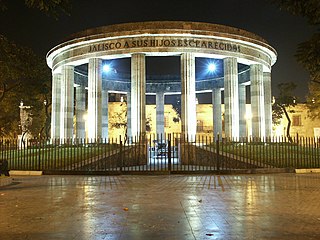
Guadalajara is a city in western Mexico and the capital of the state of Jalisco. According to the 2020 census, the city has a population of 1,385,629 people, making it the 8th most populous city in Mexico, while the Guadalajara metropolitan area has a population of 5,268,642 people, making it the third-largest metropolitan area in the country and the twenty-second largest metropolitan area in the Americas. Guadalajara has the second-highest population density in Mexico, with over 10,361 people per square kilometer. Within Mexico, Guadalajara is a center of business, arts and culture, technology and tourism; as well as the economic center of the Bajío region. It usually ranks among the 100 most productive and globally competitive cities in the world. It is home to numerous landmarks, including Guadalajara Cathedral, the Teatro Degollado, the Templo Expiatorio, the UNESCO World Heritage site Hospicio Cabañas, and the San Juan de Dios Market—the largest indoor market in Latin America.

La Piedad is a municipality located at in the north-west of the Mexican state of Michoacán, bordering Jalisco and Guanajuato. The municipal seat is the city of La Piedad de Cabadas. The original colonial name was San Sebastián. It is bordered by the town of Santa Ana Pacueco, Guanajuato. Both cities straddle the Lerma River. La Piedad's population was 106,490 inhabitants in the 2020 census. The municipality has an area of 284.11 km². It is bordered by the states of Jalisco and Guanajuato.

Joaquín Cordero was a Mexican actor of the cinema, theatre and telenovelas.

Alejandro Colunga Marín is a Mexican artist, painter and sculptor.

John Mill Ackerman Rose is an American-born, naturalized Mexican political activist, TV host, and academic at the National Autonomous University of Mexico (UNAM).

Teatro Degollado is a neoclassical Mexican theater known for its diverse performances and artistic design. It is located in the central plaza of Guadalajara, Jalisco, Mexico on Belen Street between Hidalgo Avenue and Morelos Avenue. Many performances from cultural Mexican dances to international operas take place in this building. Meant to be a monument of Guadalajara's culture, the theater was inaugurated in September 1866 and is a major landmark of the city.
Ramón Sagredo (1834–1870) was a 19th-century Mexican painter and photographer who worked under the patronage of Emperor Maximilian and decorated the former cupola of "La Profesa" with the Catalan master Pelegrí Clavé.

Ricardo Lancaster-Jones y Verea, MA BE KHS was a Mexican historian and scholar who made significant contributions toward the study of the haciendas of the State of Jalisco (Mexico) in the twentieth century. His enthusiasm for history led him to become a professor of Regional History at the Faculty of Philosophy and Letters of Universidad Autónoma de Guadalajara in 1965. Later on, in 1973, he earned his MA degree in Latin American Studies at the University of New Mexico.

The Rotonda de los Jaliscienses Ilustres is a landmark in Centro, Guadalajara, in the Mexican state of Jalisco.
Events in the year 1862 in Mexico.

Jorge Aristóteles Sandoval Díaz was a Mexican politician belonging to the Institutional Revolutionary Party (PRI). He served as Governor of Jalisco from 2013 to 2018.

Julio Alberto Castillo Rodríguez, commonly referred to by his alias Ojo de Vidrio, is a Mexican suspected drug lord and former high-ranking leader of the Jalisco New Generation Cartel (CJNG), a criminal group based in Jalisco. He is the son-in-law of Nemesio Oseguera Cervantes, the leader of the CJNG and one of Mexico's most-wanted drug lords. He was reportedly responsible for managing money laundering schemes for the CJNG.

Martín Arzola Ortega, commonly referred to by his alias "El 53", was a Mexican convicted drug lord and former high-ranking leader of the Jalisco New Generation Cartel (CJNG), a criminal group based in Jalisco. He worked under Nemesio Oseguera Cervantes, the alleged top leader of the CJNG. Arzola Ortega began his criminal career in 1998 as a cargo truck thief and eventually joined the Milenio Cartel, the predecessor group of the CJNG. After several of his bosses were arrested and/or killed, he founded the CJNG with other defectors in the 2010s.
Events in the year 1960 in Mexico.

José Patricio Gabriel de la Bárcena Ponze was a politician from Durango City, Mexico. He was born in 1807, and died in 1881 in Victoria de Durango, Durango.

A statue of Ignacio Vallarta is installed along the Rotonda de los Jaliscienses Ilustres, in Centro, Guadalajara, in the Mexican state of Jalisco.

Antonio Rojas, nicknamed El Matacuras, was a Mexican Guerrilla who participated in the Reform War and the Second French intervention in Mexico. He fought independently in both wars due to his differing and controversial strategies and tactics throughout both wars until being killed at Mascota, Jalisco.

Pedro Ogazón Rubio was a Mexican military officer and politician. He served as the governor of Jalisco, Minister of War, a local and federal deputy, and a magistrate of the Supreme Court of Justice.















